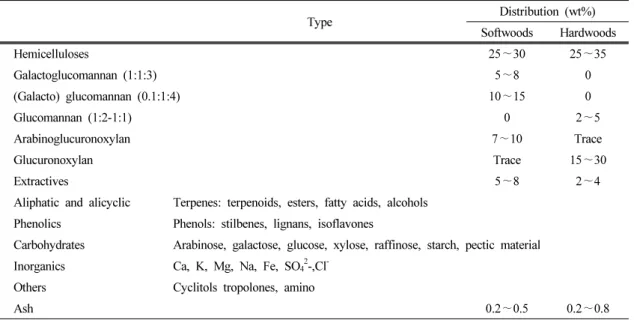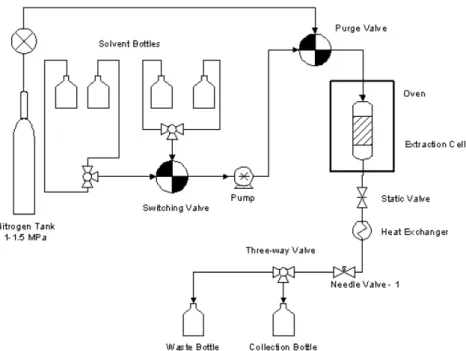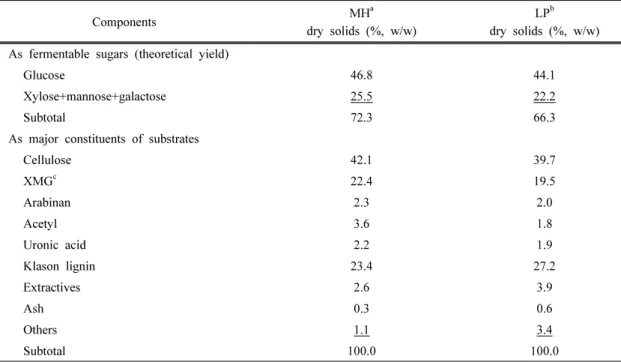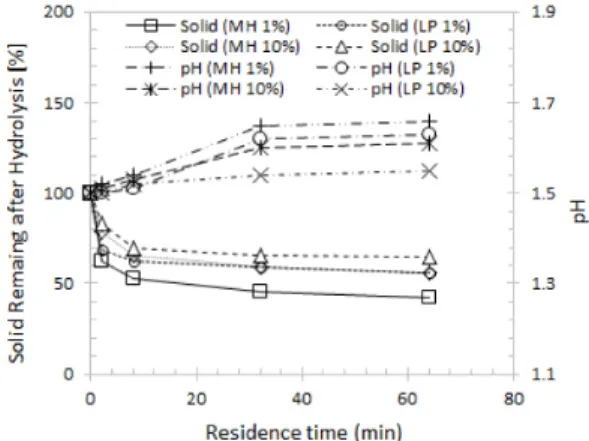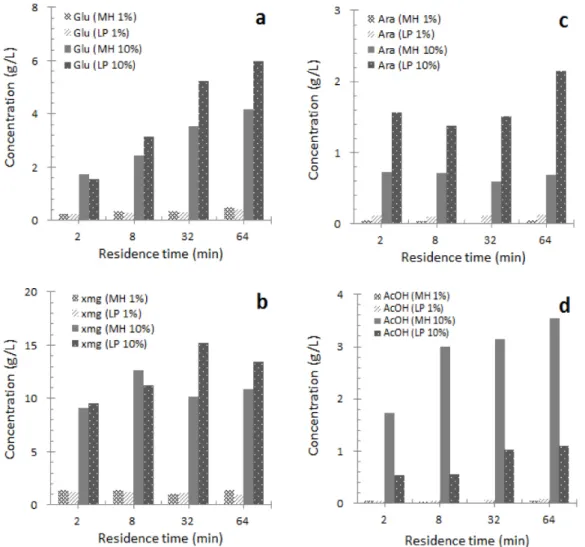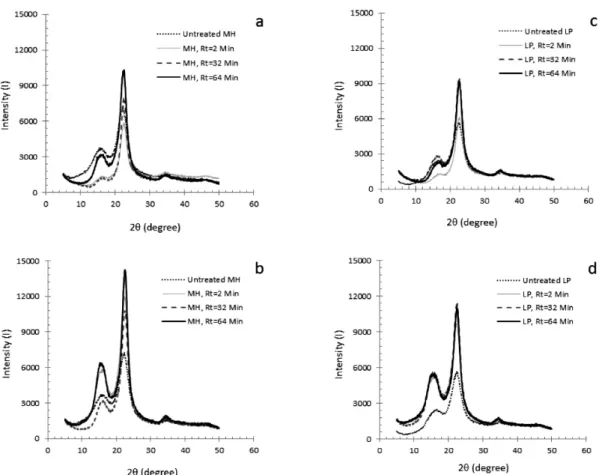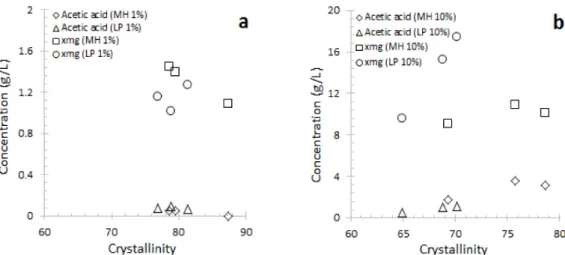Extraction of Hemicellulosic Sugar and Acetic Acid from Different Wood Species with Pressurized Dilute Acid Pretreatment
1Byung-Hwan Um
2†⋅Seong-Jik Park
3ABSTRACT
Extraction is a necessary element in the bioconversion of lignocellulosics to fuels and chemicals. Although various forms of chemical pretreatment of cellulosic materials have been proposed, their effectiveness varies depending on the treatment conditions and substrate. In this study, mixed hardwood (MH) and loblolly pine (LP) were pretreated with dilute acid in a 100 mL accelerated solvent extraction (ASE) at the predetermined optimal conditions: temperature:
170°C, acid concentration: 0.5% (w/v), and reaction time: 2~64 min. This method was highly effective for extracting the hemicellulose fraction. Total xmg (defined as the sum of xylose, mannose, and galactose) can be extracted from milled MH and LP through pressurized dilute acid treatment in maximum yields of 12.6 g/L and 15.3 g/L, respectively, representing 60.5% and 70.4% of the maximum possible yields, respectively. The crystallinity index increased upon pretreatment, reflecting the removal of the amorphous portion of biomass. The crystalline structure of the cellulose in the biomass, however, was not changed by the ASE extraction process.
Keywords : Acetic acid, Crystallinity, Hemicellulose, Dilute acid extraction, Accelerated solvent extraction (ASE)
1. INTRODUCTION
1)In recent years, the extraction of hemicellu- loses from wood has attracted increasing atten- tion, mainly because of the interest in ethanol production during mechanical pulping (Um 2012; Liu and Amidon 2007; Ragauskas et al.
2006). Hemicelluloses are heteropolymers of 5- and 6-carbon sugars with side chains. Table 1 shows the major hemicellulose constituents to-
gether with wood biomass extractives. If one considers cellulose as a one-dimensional poly- mer, most hemicelluloses are two-dimensional polymers. Hemicellulose oligomers can be parti- ally extracted from hardwood chips through dis- solution in water at high temperatures (Amidon et al., 2008; Liu et al., 2006), and xylose or hemicellulose sugars can be fermented to etha- nol by microorganisms (Qureshi et al., 2006;
Jeffries and Jin, 2004). Hemicellulosic sugars
1 Received February 17, 2014; accepted March 6, 2014
2 Department of Chemical Engineering and Research Center of Chemical Technology, Hankyong National University, Gyeonggi-do 456-749, Korea
3 Department of Bioresources and Rural System Engineering, Hankyong National University, Gyeonggi-do 456-749, Korea
† Corresponding author : Byung-Hwan Um (e-mail: bhum11@hknu.ac.kr)
Type Distribution (wt%) Softwoods Hardwoods
Hemicelluloses 25∼30 25∼35
Galactoglucomannan (1:1:3) 5∼8 0
(Galacto) glucomannan (0.1:1:4) 10∼15 0
Glucomannan (1:2-1:1) 0 2∼5
Arabinoglucuronoxylan 7∼10 Trace
Glucuronoxylan Trace 15∼30
Extractives 5∼8 2∼4
Aliphatic and alicyclic Terpenes: terpenoids, esters, fatty acids, alcohols Phenolics Phenols: stilbenes, lignans, isoflavones
Carbohydrates Arabinose, galactose, glucose, xylose, raffinose, starch, pectic material Inorganics Ca, K, Mg, Na, Fe, SO42-,Cl-
Others Cyclitols tropolones, amino
Ash 0.2∼0.5 0.2∼0.8
Table 1. Major components of hemicelluloses and extractives (Rousseau et al., 2011).
may also be used as building blocks for bio- degradable plastics (Keenan et al., 2004) or other products and chemicals that are currently made from petroleum (Liu et al., 2006). The residual woodchips can be processed into pulp to make paper, burned as a renewable energy source, or converted to reconstituted wood pro- ducts such as fiberboard or pellets (Amidon, 2006; Amidon and Liu, 2009). This process would add additional products to the current pa- per and wood energy business, triggering evolu- tion toward wood-based biorefineries (Myerly et al., 1981). The production of pulp and/or paper products from cellulose remains attractive today because cellulose has a higher value as a pulp than as a sugar. However, the pulp and paper industry in the United States and Canada has actually been declining steadily in recent years as production shifts to higher growth areas such as China and Brazil. Further conversion of cel- lulose into sugars and/or other chemicals/liquid fuel is highly desirable because of the higher
future demand predicted. A purpose-built bio- refinery would include all these process alter- natives, though adaptations of current process- ing locations may not include all the alterna- tives.
More recently, much research has been car- ried out on xylose dissolved in pulp and on bi- orefinery; since xylan is the main component of hardwood hemicelluloses, xylooligomers and xylose are the main products obtained through hydrothermal treatments of this raw material.
Sugar-degradation products (such as furfural or
hydroxymethylfurfural) and acetic acid (genera-
ted from acetyl groups) can also appear in the
reaction media. Extraction and subsequent acid
hydrolysis are commonly performed in water
media. There are many advantages of using wa-
ter as the sole solvent. However, harsh reaction
conditions, that is, either a high temperature or
a combination of high temperature and strong
acid, are required, and thus the processes are
limited to large-scale operations for economic
Fig. 1. Schematic diagram of ASE 300 (Accelerated Solvent Extractor).
success. With the aim of achieving the com- plete fractionation of wood into hemicelluloses, lignin, and cellulose, Li et al. (2005) suggested steam-explosion treatment, in which autohy- drolysis is the main reaction. Most of these stud- ies were focused on hardwoods, because this type of biomass is under-utilized in many coun- tries, but also because hardwoods are easier to fractionate by autohydrolysis. The extraction of hemicelluloses from hardwoods prior to kraft pulping has also been studied recently (Park et al., 2013; Karlsson et al., 2006; van Heiningen 2006; Leschinsky et al., 2007).
The objective of this study was to assess and compare the compositions of hemicellulose ex- tracts obtained under an extraction temperature of 170°C, with a dilute acid concentration of 0.5% (w/v), and with various solid-to-liquid ra- tios using hardwood (mixed hardwood) and softwood (loblolly pine). Experiments were also
carried out to investigate the extent of changes in chemical composition as a function of cellu- lose crystallinity.
2. MATERIALS AND METHODS
2.1. Raw Material
Mixed hardwood and loblolly pine (Pinus taeda) chips were used throughout this study, and were supplied by the Old Town Fuel &
Fiber Kraft Pulp Mill in Old Town, ME. The
hardwood chips consisted of roughly 50% ma-
ple, with the remainder being mostly beech and
poplar. The chips were milled with a granulator
(MDS 120/150 granulators, Hellweg Maschinen-
bau GmbH & Co. KG, Roetgen, Germany)
equipped with a 2-mm rejection screen. The
milled materials were further separated to give
an average size of 30~40 mesh (0.595~0.420
Parameters Values
Temperature 170°C
Acid concentration 0.5% (w/v) H2SO4
Particle size < 2 mm
Residence time 2∼64 min
Substrate Mixed hardwood and loblolly pine Table 2. Values of parameters used in ASE 300 runs
mm) by using a portable USA standard Sieve
(Tyler Industrial products, Mentor, OH) for de- termination of the total solids/moisture ratio and for carbohydrate content analysis.
2.2. Equipment and Pretreatment Procedure
Fig. 1 shows a schematic diagram of an ac- celerated solvent extraction (ASE) system. The ASE 300 was purchased from Dionex Corpora- tion. For this study we used Dionium
®100 mL reactor cells, which are manufactured to be re- sistant to corrosion by dilute acid. Sulfuric acid was used as the catalyst, and was diluted to a working solution of 0.5% (w/v). Air-dried wood mills (1 or 10 g) were packed into a 100 mL Dionium cell. Room-temperature acid solution was pumped into the cell when already in the oven, and was allowed to equilibrate with the oven temperature (170°C). We used a constant- pressure mode, which maintained a pressure of 1,500 psi in the cell. The cell was held at static temperature and pressure for the desired re- action time, and then evacuated into the 250 mL collection vessel. The cell was flushed with one reactor volume of the acid solution and then purged with nitrogen for 30s. The cell was then flushed with four reactor volumes of de- ionized (DI) water to remove any excess hydro- lyzed sugars in the cell and quench the hydrol- ysis reaction. Table 2 presents an outline of the extraction conditions investigated in the experi- ments.
2.3. Analysis of Extract Solutions
The sugar composition of the reaction prod- ucts was analyzed quantitatively by HPLC. The
Shimadzu model (LC-10AT Liquid Chromato- gram, Shimadzu Corp., Kyoto, Japan) HPLC used for carbohydrates measurement had Bio- Rad Aminex HPX-87H (300 × 7.8 mm) and a Cation H micro-guard cartridge (30 × 4.6 mm) (Bio-Rad Laboratories Inc., Hercules, CA). The column was maintained at 60°C, and 5 mM H
2SO
4was used as eluent at a flow rate of 0.6 mL/min. All the sugar peaks were detected with a refractive index (RI) detector and UV absorp- tion (280 nm), and were identified and quan- ti-fied through comparison with the retention times of authentic standards. The Bio-Rad Aminex HPX-87H analytical column allows concurrent analysis of sugars, small-chain organic acids, and sugar degradation products, but does not distinguish between the sugars xylose, mannose, and galactose, which are therefore reported as the aggregate xmg. A previous study showed that the quantification of total sugars in Green Liquor extracts is as effective with the HPX- 87H column as with other methods that are ca- pable of differentiating all of the sugars present (Um and van Walsum, 2010).
2.4. X-ray Diffraction Analysis
The crystallinities of untreated and treated wood
chips were measured at the XRD Laboratory,
AWEC, University of Maine with a Rigaku
Components MHa dry solids (%, w/w)
LPb dry solids (%, w/w) As fermentable sugars (theoretical yield)
Glucose 46.8 44.1
Xylose+mannose+galactose 25.5 22.2
Subtotal 72.3 66.3
As major constituents of substrates
Cellulose 42.1 39.7
XMGc 22.4 19.5
Arabinan 2.3 2.0
Acetyl 3.6 1.8
Uronic acid 2.2 1.9
Klason lignin 23.4 27.2
Extractives 2.6 3.9
Ash 0.3 0.6
Others 1.1 3.4
Subtotal 100.0 100.0
aMixed hardwood
bLoblolly pine
cXMG= xylan+mannan+galactan
Table 3. Chemical composition of hardwood and softwood on dry basis
Powder X-ray Diffractometer (Rigaku Denki Co., Japan). The specimen was scanned at 2°/min from 2 θ = 10° to 26° with a step size of 0.05°. The definition of crystallinity index is CrI = (I
002–I
am) / I
002× 100
, where I
002is the intensity of the diffraction from the 002 plane at 2 θ= 22.6° and I
amis the intensity of the background scatter measured at 2 θ≈ 18.7° (Segal et al., 1959).
3. RESULTS AND DISCUSSION
3.1. Chemical Composition of Raw Material The chemical composition of loblolly pine
was determined according to NREL Laboratory
Analytical Procedures (Sluiter et al., 2008). The
component analysis results of rape straw are
presented in Table 3. As shown in Table 3, the
carbohydrate fractions (cellulose and hemicellu-
lose) of mixed hardwood (MH) and loblolly
pine (LP) were determined to be 64.5 wt% (42.1
wt% glucan, 22.4 wt% XMG, and 2.3 wt% ara-
binan) and 59.2 wt% (39.7 wt% glucan, 19.5
wt% XMG, and 2.0 wt% arabinan), respec-
tively. Analysis of MH and LP show that theo-
retical fermentable sugars accounted for more
than 72.0% and 66.0%, respectively, on a dry
matter basis. The insoluble lignin (Klason lig-
nin) contents were 23.4 wt% and 27.2 wt%, re-
spectively, and only small amounts of extrac-
tives (MP = 3.52 ± 0.12 wt%, LP = 3.52 ± 0.12
Fig. 2. Percent of solid remaining and pH change in the hydrolyzate after dilute acid extraction as a function of residence time
wt%) were detected. Acetyl in MP and LP ac- counted for 3.6% and 1.8% respectively, and uronic acid was amounted to 2.2% and 1.9%, respectively. The results are in agreement with previous reports on the composition of woody biomass (Um and van Walsum, 2010; Frederick et al., 2008).
3.2. Total Solid Recovery and pH Change in Hydrolyzate
For the evaluation of the efficiency of dilute acid as a pretreatment for MH and LP, the sol- id yield was calculated in relation to the raw material. Fig. 2 shows the trend of solid yield and pH in the hydrolyzate. For 1% solid load- ing, the solid yields ranged from 42.4% to 62.1% (MP) and from 55.8% to 68.7% (LP), with average values of 60.4% and 69.3%, re- spectively, of the initial dry weight. Meanwhile, a lower solid recovery for 10% solid loading was determined after pretreatment under the same severities. As expected, owing to the en- hanced effect on the removal of water-soluble components, the overall solubilization of woody biomass increased under harsher conditions, which is consistent with the trend reported in the literature (Kobayashi et al., 2009; Pérez et al., 2007).
Fig. 2 shows the pH of the hydrolyzates as a function of reaction time for the extraction experiments. For dilute acid extractions at 0.5%
(w/v), the pH of the final extraction liquor in- creases slightly above 1.5. The results thus ob- tained show that higher severity increase the pH further, indicating more complete consump- tion of the added dilute acid chemicals followed by an increase in acetic acid release from hemicellulose.
3.3. Sugar and Acetic Acid Content in Hydrolyzate
Extracts of hemicelluloses and oligosaccharides were analyzed immediately after dilute acid extraction. The hemicellulosic sugars, formed by hydrolysis during extraction, were determi- ned by NREL standard analytical procedures (Sluiter et al., 2006). All results for the ex- traction of milled woods are presented in Figure 3 as function of reaction time and solid loading percent. The maximum yield of xmg of 12.6 g/L for MP was found under conditions of 10%
solid loading for 8 min at 170°C, and a yield
of slightly over 15.0 g/L was obtained for LP,
which represents 70.1% of the available xmg
(Fig. 3b). The xmg yields dropped clearly for
MP and LP after 8 and 32 min, respectively, at
170°C. The decrease was most extensive for
xmg, probably because of acidic degradation,
mainly of furfural (Lai, 2001). The yields of
galactoglucomannan-based sugars also decreased
slightly. The decreased yield of galactogluco-
mannan is probably related to the hydrolysis of
Fig. 3. (a) Sugars (glucose, xmg, and arabinose) and acetic acid yields from dilute acid extraction of MP and LP as a function of solid loading and residence time: (a) glucose, (b) xmg, (c) arabinose, and (d) acetic acid.
acetyl groups, leading to the lower water sol- ubility of galactoglucomannan. Meanwhile, a sugar yield increase was observed for glucose under the reaction conditions employed (Fig.
3a). This may be explained by the low-sol- ubility cellulose, which is probably partially de- graded under the dilute acid conditions applied.
The relatively few arabinose units in the ex- tracts are probably derived mainly from arabi- nogalactans, which are minor water-soluble pol-
ysaccharides that also occur in wood.
Both free and esterified acetic acid in the ex-
tracts were analyzed by HPLC. The amount of
free acetic acid increased with reaction time
(Fig. 3d). The degree of acetylation was calcu-
lated by considering the number of mannose
units in the extracts, with the assumption that
all acetyl groups are on the mannose units, as
documented to be the case for galactoglucoman-
nan released from thermomechanical pulp (TMP)
Fig. 4. XRD patterns of untreated MP and LP.
Fig. 5. Comparison of XRD profiles with untreated and extracted samples as a function of reaction time. Note:
(a), (c) 1% (w/w) solid loading and (b), (d) 10% (w/w) solid loading.
(Hannuksela, 2004). As expected, we also found
that acetic acid derived from MH release in-
creased proportionally with reaction time. In ad-
dition, as expected, less release of acetic acid
was detected for LP over the whole reaction
time. The acetate formation of MP appears to
peak at a temperature of 170°C and reaction
time of 64 min. However, essentially, all acetyl
groups were hydrolyzed from the dissolved
galactoglucomannan. A high degree of acetyla-
tion is necessary for good water solubility, and
accordingly, for a high extraction yield of
high-molar-mass galactoglucomannan.
Fig. 6. Effect of CrI (Crystallinity Index) on extraction yield in ASE. Note: ASE extraction conditions: 0.5%
(w/v) sulfuric acid, 170°C, 2∼64 min.
3.4. Crystallinity and Hemicellulose Extraction
The physical properties and cellulose micro- structure are among the factors potentially influ- encing enzymatic hydrolysis and fermentation processes. One frequently cited property is bio- mass crystallinity. We measured the X-ray dif- fraction patterns of treated and untreated bio- mass as a function of treatment time (Figs. 4 and 5), from which the crystallinity indexes were determined. The diffraction patterns show that the CrI values of MH and LP actually in- crease with ASE treatment time (Fig. 5). The CrI of treated milled wood chips as a function of extraction yield is shown in Fig. 6. The CrI is strongly influenced by biomass composition, but it is found that the yield of acetic acid is not affected significantly by the CrI. For ligno- cellulosic biomass, the crystallinity index meas- ures the relative amount of crystalline cellulose in the total solid. ASE dilute acid treatment mainly removes xylan, which is amorphous, so the CrI value increases after ASE extraction.
An increased CrI after biomass pretreatment has been observed in many previous investigations (Kasahara et al., 2001; Chang and Holtzapple, 2000; Tanahashi et al., 1983). It is uncertain, however, whether the cellulose structure in MP and LP is altered by the ASE treatment. In the XRD of Fig. 5, the peak height of the MP and LP increases approximately in proportion with the cellulose content of the biomass. This in- dicates that the increased CrI upon ASE treat- ment is caused primarily by the removal of amorphous substances (lignin and hemicellulose), and is not due to changes in the basic crystal- line structure of the cellulose. The results agree with the findings of Puri (1984), who reported that the crystallinity of cellulose in various lignocellulosic materials remains unchanged ir- respective of the structural changes caused by several pretreatments.
4. CONCLUSIONS
Hemicellulosic sugars, which contain a major
part of their acetyl groups, can be extracted
from milled MH and LP through pressurized di- lute acid treatment in maximum yields of 12.6 g/L and 15.3 g/L, respectively, representing 60.5%
and 70.4% of the maximum possible yields, respectively. Such xmg yields can be obtained through batch extraction of milled wood at tem- peratures of 170°C with extraction times rang- ing from 8 to 32 min. Longer extraction times would lead to a slightly higher pH because of the deacetylation of galactoglucomannan, and consequently, the solubility of xmg and its yield would decrease. The severe reaction con- ditions might also be caused partly by the ur- onic acids released into the water phase from pectins and xylans. Other major compound groups in the extracts are lignin and acetic acid.
The CrI of woody biomass rises after ASE ex- traction mainly because of the removal of amor- phous substances. It could not be found that the crystalline structure of the glucan content of the biomass is changed because of the ASE extrac- tion process.
ACKNOWLEDGEMENTS
This work was supported financially by a National Research Foundation of Korea (NRF) grant funded by the Korea government (MEST), Project No.
2012R1A1A1003107.
REFERENCES
1. Amidon, T. 2006. The biorefinery in New York:
Woody biomass into commercial ethanol. Pulp and Paper Canada, 107: 47~50.
2. Amidon, T. and Liu, S. 2009. Water-based woody biorefinery. Biotechnology advances, 27:
542~550.
3. Amidon, T., Wood, C., Shupe, A., Wang, Y., Graves, M., and Liu, S. 2008. Biorefinery: Con- version of woody biomass to chemicals, energy and materials. Journal of Biobased Materials and
Bioenergy, 2: 100~120.
4. Chang, V. S. and Holtzapple, M. T. 2000. Fun- damental factors affecting biomass enzymatic reactivity. Appl. Biochem. Biotechnol., 84~86, 5~37.
5. Frederick, W. J. Jr., Lien. S. J., Courchene, C.
E., DeMartini, N. A., Ragauskas, A. J., and Iisa, K. 2008. Production of ethanol form carbohy- drates from loblolly pine: A technical and eco- nomic assessment. Bioresource Technology, 99:
5051~5057.
6. Hannuksela, T. and Herve, C. 2004. NMR struc- tural determination of dissolved O-acetylated gal- actoglucomannan isolated from spruce thermo- mechanical pulp. Carbohydr. Res., 339: 301~
312.
7. Jeffries, T. and Jin, Y. 2004. Metabolic enginee- ring for improved fermentation of pentoses by yeasts. Applied Microbiology and Biotechnology, 63: 495~509.
8. Karlsson, P., Roubroeks, J. P., Glasser, W. G., and Gatenholm, P. 2006. Optimization of the process conditions for the extraction of hetero- polysaccharides from birch (Betula pendula). In:
Feedstocks for the Future. ACS Symp., Series 921, pp. 321~333.
9. Kasahara, K., Sasaki, H., Donkai, N., Yoshihara, T., and Takagishi, T. 2001. Modification of tren- cel with treatment of ferric sodium tartrate com- plex solution. I. Effect of treatment condition.
Cellulose, 8: 23~28.
10. Keenan, T., Tanenbaum, S., Stipanovic, A., and Nakas, J. 2004. Production and characterization of poly-beta-hydroxyalkanoate copolymers from Burkholderia cepacia utilizing xylose and levu- linic Acid. Biotechnology Progress, 20: 1697~
1704.
11. Kobayashi, N., Okada, N., Hirakawa, A., Sato, T., Kobayashi, J., Hatano, S., Itaya, Y., and Mori, S. 2009. Characteristics of solid residues obtained from hot-compressed-water treatment of woody biomass. Ind. Eng. Chem. Res., 48(1):
373~379.
12. Lai, Y. Z. 2001. Chemical degradation. In: Wood
and Cellulose Chemistry. Eds. Hon, D.N.-S., Shiraishi, N. Marcel Dekker, pp. 443~512, New York.
13. Leschinsky, M., Patt, R., and Sixta, H. 2007.
Water prehydrolysis of E. globulus with the main emphasis on the formation of insoluble components. In: Proceeding of the Pulp Paper Conf., Fibre Modifications and Brightening, pp.
7~14, Finnish Paper Engineers Association, Helsinki, Finland.
14. Li, J., Henriksson, G. and Gellerstedt, G. 2005.
Carbohydrate reactions during high-temperature steam treatment of aspen wood. Appl. Biochem.
Biotechnol., 125: 175~188.
15. Liu, S., Amidon, T., Francis, R., Ramarao, B., Lai, Y., and Scott, G. 2006. From forest biomass to chemicals and energy. Biorefinery initiative in New York State. Industrial Biotechnology, 2:
113~120.
16. Myerly, R., Nicholson, M., Katzen, R., and Taylor, J. 1981. The forest refinery. Chemtech, 11: 186~192.
17. Park, S.J., Moon, J.K., and Um, B.H. 2013.
Evalulation of the Efficiency of Solvent Systems to Remove Acetic Acid Derived from Pre- Pulping Extraction. J. Korean Wood Sci. &
Tech., 41(5): 447~455.
18. Perez, J. A., Gonzalez, A., Oliva, J. M., Balles- teros, I., and Manzanares, P. 2007. Effect of pro- cess variables on liquid hot water pretreatment of wheat straw for bioconversion to fuel-ethanol in a batch reactor. J. Chem. Technol. Biotechnol.
82(10): 929~938.
19. Puri, V. P. 1984. Effect of crystallinity and de- gree of polymerization of cellulose on enzymatic saccharification. Biotechnol. Bioeng., 26: 1219~
1222.
20. Qureshi, N., Dien, B., Nichols, N., Saha, B., and Cotta, M. 2006. Genetically engineered Escherichia coli for ethanol production from xylose substrate and product inhibition and kinetic parameters.
Food and Bioproducts Processing 84: 114~122.
21. Ragauskas, A. J., Nagy, M., Kim, D. H., Eckert, C. A., Hallett, J. P., and Liotta, C.L. 2007. From wood to fuels: integrating biofuels and pulp production. Ind. Biotechnol, 2: 55~65.
22. Rousseau, R., Hawkes, J., and Liu, S. 2011.
Growing systems for traditional and new for- est-based materials, in the Plant Biomass Con- version, Elizabeth E. H., Peter N. P., and Randall P. Ed., pp. 69, John Wiley & Sons Ltd, West Sussex, UK.
23. Segal, L., Creely, J. J., Martin, A. E., and Conrad, C. M. 1959. An empirical method for estimating the degree of crystallinity of native cellulose us- ing the X-ray diffractometer. Textile Res. J., 29:
786~794.
24. Sluiter, A., Hames, B., Ruiz, R., Scarlata, C., Sluiter, J., and Templeton, D. 2008. Determina- tion of structural carbohydrates and lignin in biomass. National Renewable Energy Laboratory NREL/TP-510-42681 ed. Golden, CO.
25. Sluiter, A., Hames, B., Ruiz, R., Scarlata, C., Sluiter, J., and Templeton, D. 206. Determina- tion of sugars, byproducts, and degradation prod- ucts in liquid fraction process samples. National Renewable Energy Laboratory NREL/TP-510- 42623 ed. Golden, CO.
26. Tanahashi, M., Takada, S., Aoki, T., Goto, T., Higuchi, T., and Hanai, S. 1983. Characteriza- tion of explosion wood. 1. Structure and phys- ical properties. Wood Res., 69: 36~51.
27. Um, B. H. 2012. Evaluation of Secondary Acid and Enzymatic Hydrolysis of Hemicellulose in Hot Water Pre-Pulping Extract of Mixed Hard- woods. Mokchae Konghak., 40(2): 123~132.
28. Um, B. H. and van Walsum, G. P. 2010. Mass balance on green liquor pre-pulping extraction of northeast mixed hardwood. Bioresource Techno- logy. 101: 5978~5987.
29. van Heiningen, A. 2006. Converting a kraft pulp mill into an integrated forest biorefinery. Pulp Pap. Can. 107: 38~43.
